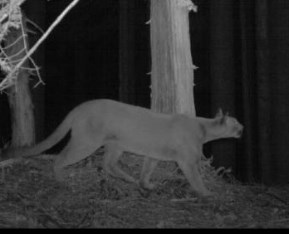|
The Olympic [Mountains] Project (OP) is an ongoing effort in extreme NW Washington state, involving state-of-the-art automated trail cameras, to obtain clear photos of sasquatches.
Click the photo to the left to access the web site for this project.
A group of experienced deer hunters from Northwest Washington, led by Derek Randles of Tahuya (businessman, deer hunter, bigfoot investigator) selected the sites for deployment of these cameras -- sites rarely visited by humans, with relatively high amounts of wild animal traffic.
Randles proposed this project to BFRO sponsor Wally Hersom. Hersom initially supplied 20 new RC60-HO units, then more when the first 20 were fully deployed. Currenly 27 are deployed.
These are revolutionary new devices with a very sensitive trigger mechanism, and the ability to shoot one photo per second (as opposed to one photo every 30 seconds, for cheaper Walmart models).
The OP's focus so far has been ridgeline routes. They have obtained some excellent shots of animals along those routes, but no *definite* images of sasquatches yet.
They are in the best zone, and are using the best trail cam equipment, but their effort will still be a process of trial and error. The amount of excellent animal shots the OP crew is already getting tells us the cameras are working. We can also see more evidence that Reconyx RC-60's are not easily noticed by wild animals at night, even when flashing in the face of a passing mountain lion.
The OP's next focus will be animal pathways closer to creeks (as opposed to ridgeline routes). Do check back on their web site every so often to see what they are getting, and to learn some of their methods for setting up trail cameas.
The OP has asked the BFRO to contribute a column on their site sharing any related wisdom we may have regarding placement techniques. It's a delicate issue, because the cameras are concealed in the woods to prevent theft, as much as to avoid detection by skittish animals.
We've already lost some units to theft, in other areas. On more than one occasion, when a Reconyx unit was cable locked to a tree, the whole tree was cut down in order to steal a camera. This is one of the reasons the BFRO does not publicize the specific locations of its field investigations.
Nevertheless, we'll provide
as much guidance as we can, because we want to encourage others to buy these cameras and deploy them in good areas.
It would be wonderful if Reconyx units did not cost $650 ... Lots more people would be able to get involved ... And that's why we're trying to identify the best new trail camera out there, with comparable features, for a much lower price.
Bushnell may have one in the works. We've tested some units from Bushell that have one good advantage over Reconyx units: The new Bushnell units are much smaller and lighter than Reconyx units, which means you can carry twice as many in a backpack. They also have a fast trigger speed, and color video in daylight. However, their LED illuminators still glow red (dimly) at night, whereas Reconyx RC-60's do not glow at all.
Visible glow of the flash not only spooks many types of passing animals, it also makes trail cameras much easier to spot by humans, which means some will be stolen no matter how well they are concealed in a forest.
Not even one consumer model trail cam has audio recording capability yet, even the ones that can record short clips of video have no sound!. Nor do any offer an accessory face plate that facilitates better camoflauging on a tree trunk.
One obvious idea would be an accessory face plate allowing a person to affix matching pieces of bark (always available as deadfall on the ground). That could be done a number of different ways. The units to which the plates attach, however, must be shaped to allow a face place to snap on and off easily over the unit.
Derek Randles has experimented with a different idea. He is making his own face plates for Reconyx units from molds of tree trunks of common northwest evergreens.
Every type of tree bark comes in different shades, depending upon the wetness of the area, and the bark's exposure to sunlight, etc. Also, tree bark often has mosses, molds, lichens, dust, etc., which add more variants of color, pattern and texture. Consequently, Derek's system will require a person to carry a small paint kit for matching the face plate exactly to its background tree trunk. That may work well, but many people need to be trying that in order to figure out the best methods for camouflaging trail cams effectively.
A face plate doesn't have to make the unit completely unnoticeable in daylight. It only has to make the unit less noticeable in daylight, from a distance. That would greatly help prevent thefts of these units in the field.
In the future it may become common for people to have something like a trail camera hanging on the inside of the front door of their home, aiming out custom peep holes to allow the unit to get photos of any person approaching their front door. Trail cams used that way would not get stolen, but would probably help police catch burglars and predators. A bad guy caught by a high-res trail camera at close range, is half way to being caught in the flesh.
|






















